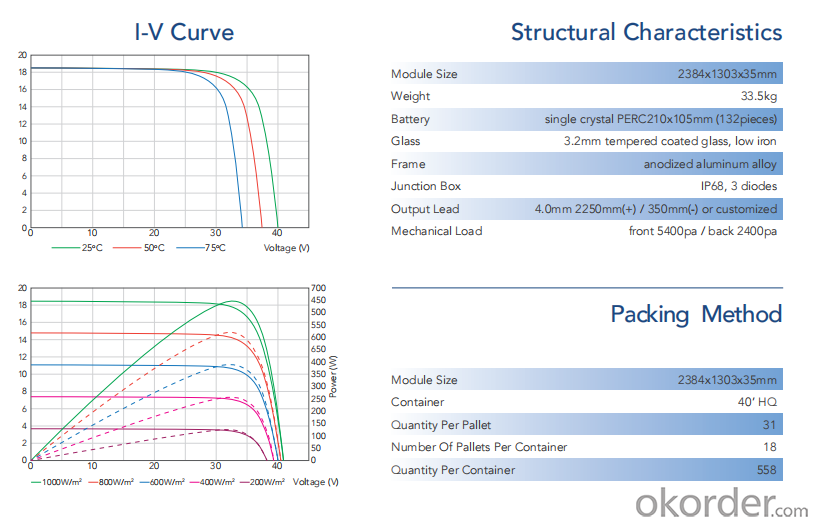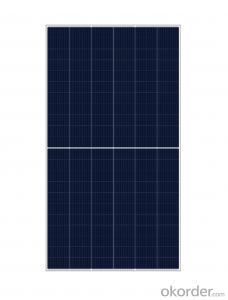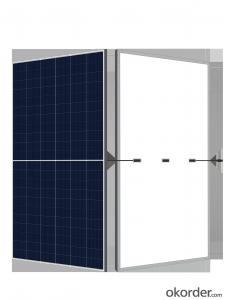G12 HC MONO SOLAR MODULE TD-650MD-132HC--TD-670MD-132HC
- Loading Port:
- China main port
- Payment Terms:
- TT OR LC
- Min Order Qty:
- 558 pc
- Supply Capability:
- 50000 pc/month
OKorder Service Pledge
Quality Product, Order Online Tracking, Timely Delivery
OKorder Financial Service
Credit Rating, Credit Services, Credit Purchasing
You Might Also Like
Item specifice
Material:
Monocrystalline Silicon
Max. Power(W):
670
Number of Cells(pieces):
66
Size:
2384x1303x35mm
Specification
1. Monocrystalline solar panel
2. Passed TUV, IEC
3. Sealed with high insulation TPT and anti-aging EVA
4. 15 YEARS’ PROUDUCT WARRANTY
30 YEARS’ LINEAR POWER WARRANTY
Description:
1. High conversion efficiency
2. It is sealed with high transparency and low iron tempered glass, anti-aging EVA and high insulation TPT.
3. Withstand high wind pressure and snow load.


- Q:I've heard that solar panels have back-up batteries for when it is cloudy or rainy that day.. is this true?
- depending whether the solar array is back to grid or stand alone. Back to grid refers to the array being connect through the inverter to the main electricity supply grid. So when you are producing electricity from the solar array it feeds back into the main grid. Now if you are using more electricity than your array is producing then none will feed into the grid. The stand alone systems require batteries, which are charged from the electricity produced by the solar array. Solar arrays produce electricity on cloudy and rainy days but at a greatly reduced rate ; therefore little to no usable electricity is produced. Stand alone systems require batteries to store the electricity for use at night time and other times when the array is not producing . The back to grid systems require little to no maintenance as the electricity produced is fed back into the electricity network and stored there. Your meter is replaced with a dual meter . It reads your usage and your production. If in Australia you will get paid for the electricity you feed back into the grid. hope this helps.
- Q:Most solar panels (the flat ones that go onto roofs of houses) reject electricity produced by the panels if they are too low in voltage. For example, on a cloudy day, although the panels may still get some sunlight to produce some electricity, it is rejected because its too low in voltage. So, does anyone have any ideas?
- What about a battery bank as a sink? By that, I mean the batteries absorb the low/high voltage, and if the solar panels do cut out, then the batteries pick up the load and keep the inverter going. Just a thought.
- Q:I am learning all about heat radiation in Physics. There is a question I am doing about Solar panels. It asks, why do glass covers improve the efficient of solar panels? I dont really understand. How do they?? thanks :D x
- For a solar thermal panel, the idea is to get the inside as hot as possible. There are three ways to lose heat - conduction, convection, and radiation. By cutting off airflow, the glass cover reduces cooling by convection.
- Q:They have been around long enough to be cheaper. Unless they are made out of a natural material that is rare and hard to find, there is no reason why they should be so expensive. On another note, I think that all low power devices like cell phones and even laptops should have solar panels. Even if it is not enough to fully power the device for a long period of time, it will provide some electricity savings and with millions of people saving a little power adds up.
- Photo okorder /... Notice it costs over $200 and it takes up a sizable amount of space. Plus you have to expose it to bright sun light. Over all this is not something the average consumer wants to spend money on or fuss with. If something is expensive, difficult or inconvenient to use then people won't use it. Just the basic economics of such a device limits its sales never mind its functionality and usability. Even if you made a small one buit into the cover to extend the battery you won't get much of an extension and you will increase the cost of your laptop. Consider how people shop, will they buy the more expensive laptop for a questionable amount of battery extension? Mass production can lower costs but in order to mass produce something you need a demand that will consume what you produce. But if no one wants the item because of the aforementioned issues than you can't justify mass producing the item. This is like the classic which came first Chicken or Egg problem, one doesn't happen without the other. Cost reduction doesn't happen without consumer demand. This is where tax incentives, subsidies, low cost loans and energy buyback contracts come into play in order to spur on demand and jump start mass production. You could also make electricity extremely expensive by taxing oil and carbon so that a Solar Cell becomes economically competitive to very expensive electricity. Problem with this option is the negative impact high energy costs have on economic activity. Just look at what happened a couple of summers ago when gas hit $4/gal. To spur on demand we need to incentives the use of Solar cells (and other alternative energy). This can be done through several means such as subsidies, tax incentives, low interest loans, energy buyback contracts etc...
- Q:I have a 500 watt inverter and battery but need solar panels to run my need. I want to have enough juice to run a computer and monitor and sometimes a 5w amp. I am not sure how much power is needed to run the computer (standard desktop with 5flat screen with an additional surround sound system) though on the side of the computer it says 5 amp but I know I used to run it and monitor and surround sound with a heating blanket on the same circuit which was rated at 20 amps. My question is that I would like to go and buy some panels (cheaply as I'm unemployed) from somewhere like Harbor Freight that would meet the need of the converter to supply enough amperage. So what size panel(s) or panels would I need to run this setup? If I am correct I think 500 watts is equal to 5 amps. Would this even work? Could I run a partial system where I could run some of the stuff to take a load off? I need to lower my electric bill somehow. Thanks!
- Solar okorder in their survival discussion in the archive, this exact project was discussed at length.
- Q:Do solar panels work at night?
- No, solar panels do not work at night because they require sunlight to generate electricity.
- Q:can solar panels have glass between the panels and the sun?
- You're going to suffer a loss of output if you do.? How much depends on your exact conditions. Standard window glass (which I assume you want to use) loses light through both absorption and reflection.? It also retains heat.? Silicon PV panels use special low-iron glass (without the green tinge) to minimize absorption, and some have anti-reflective coatings.? They also lose output as the temperature goes up, and a window in front will retain heat. If your panel is behind a window with panes, it may suffer a serious loss of output due to selective shading of some cells in a string (the panel needs all cells in light to produce electricity). So yes and no.? You can put a solar panel behind a window and it will work, but not as well (perhaps very poorly); how much you lose depends on the particulars.
- Q:Can solar panels be installed on wineries or vineyards?
- Yes, solar panels can be installed on wineries or vineyards. In fact, many wineries and vineyards around the world have adopted solar energy systems to power their operations and reduce their carbon footprint.
- Q:i don't know very much about it, but can you somehow take off the little solar panels off of the outdoor light things and make it so you can hook an outlet up to it and plug in to it like a phone charger for electricity.
- Little solar panels on lights are very low power. The battery in one such may be 0.5 Amp-hours and .2 V ; it may be different but it should be marked on the panel/battery/manual. An outlet in your house is designed to run on 20 V (typically in N. Am.) and they run on alternating current (AC) whereas the panel generates direct current (DC). (If you don't know the difference, do not worry to much but just understand that they are not directly compatible.) You therefore need an inverter to change DC to AC (and lose some although inverters are now very efficient). But the amount of power generated by those panels is still very small. That is why solar lights are low power (just a few watts in most cases). To make things even more irritating, phone chargers do not work off 20 V AC as you are charging the battery and need a low voltage DC -- which is what the solar panel is giving you. It is almost certain that the voltage from the panel will be less than the voltage required for the phone. The charger is mostly cable but there is a black box incorporated and it should say what the voltage and current output are (the input will be 20V). So you should be able to overcome this not by hooking up the panel to a 20V outlet and then plugging the charger in but by hooking up the panel to the phone directly if you can get enough voltage out of the solar panel (or hook up several) and if you fashion a connection device. They already make them -- solar battery chargers and I am sure you can enter that into a search engine and find loads. Typically the panel alone is much more than a solar light -- which shows the relative power requirements.
- Q:i check the diodes in the backside of solar panels it reads out to be 0.433 each give me the same result but i was amazed when i check out the last two one which on clamp meter screen give me ''0L'' what this means? is that diode have malfunctions??is this reasons that the output of solar has been decreased?
- First of all, make sure that you are taking readings in the dark (with the solar panel indoors and covered). 0.433 is a reasonable forward voltage for a Schottky diode. Ideally, it diode should read open one way (possibly OL for your meter), and 0.4 the other way. If it's reading OL both ways, the diode is bad. You can either unsolder it or cut it out and verify that it is bad.
1. Manufacturer Overview |
|
|---|---|
| Location | |
| Year Established | |
| Annual Output Value | |
| Main Markets | |
| Company Certifications | |
2. Manufacturer Certificates |
|
|---|---|
| a) Certification Name | |
| Range | |
| Reference | |
| Validity Period | |
3. Manufacturer Capability |
|
|---|---|
| a)Trade Capacity | |
| Nearest Port | |
| Export Percentage | |
| No.of Employees in Trade Department | |
| Language Spoken: | |
| b)Factory Information | |
| Factory Size: | |
| No. of Production Lines | |
| Contract Manufacturing | |
| Product Price Range | |
Send your message to us
G12 HC MONO SOLAR MODULE TD-650MD-132HC--TD-670MD-132HC
- Loading Port:
- China main port
- Payment Terms:
- TT OR LC
- Min Order Qty:
- 558 pc
- Supply Capability:
- 50000 pc/month
OKorder Service Pledge
Quality Product, Order Online Tracking, Timely Delivery
OKorder Financial Service
Credit Rating, Credit Services, Credit Purchasing
Similar products
New products
Hot products
Related keywords




























